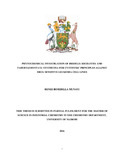| dc.description.abstract | There are various treatment options that are available for the treatment of cancer. However, development of multidrug resistant cancer has become a global health challenge in the fight against cancer. Bridelia micrantha (Euphorbiaceae) has been used traditionally by people within the vicinity of Kakamega Forest for the treatment of tumors and related ailments. Despite its widespread use, its cytotoxicity has not been fully established. Tabernaemontana ventricosa (Apocynaceae) is known to contain indole and bis-indole alkaloids that have shown to elaborate anticancer principles. However, these cytotoxic principles have not been fully documented. This study therefore sought to investigate the phytochemical and anticancer principles of both B. micrantha and T. ventricosa to produce lead compounds to combat drug sensitive and multidrug resistant (MDR) cancer as well as validate the traditional uses of B. micrantha so as to improve the existing traditional knowledge. The stem bark of Bridelia micrantha and root bark of Tabernaemontana ventricosa were subjected to extraction by cold percolation and the crude extracts underwent chromatographic separation leading to the isolation of six compounds. The compounds were characterized using spectroscopic methods and identified as friedelin (1), trans-triacontyl-4-hydroxy-3-methoxycinnamate (2), betulinic acid (3), catechin (4), stigmasterol (5a) and β-sitosterol (5b). The crude extract and isolated compounds from B. micrantha were tested for their cytotoxicity and anticancer activity towards drug sensitive leukemia cell lines. The crude extract of B. micrantha showed a cell viability of 31.5% at the tested concentration (10μg/ml) with an IC50 value of 9.43μg/ml and thus showed good activity towards the drug sensitive leukemia cell lines. The compound, trans-triacontyl-4-hydroxy-3-methoxycinnamate (2) showed an interesting cell viability of 31.13% at 1 μg/mL. However, friedelin (1), betulinic acid (3) and catechin (4) showed cell viability of <30% (cell inhibition of <70%) at the tested concentration of 1μg/ml and were thus considered inactive. From this study, the stem bark of B. mainly used for the management of cancer by people within Kakamega Forest, showed good anticancer activity and should therefore be subjected to efficacy trials for possible anticancer use. | en_US |



